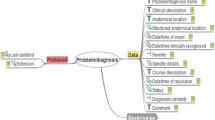Abstract
With the increasing use of anaesthesia information management systems (AIMS) there is the opportunity for different institutions to aggregate and share information both nationally and internationally. Potential uses of such aggregated data include outcomes research, benchmarking and improvement in clinical practice and patient safety. However, these goals can only be achieved if data contained in records from different sources are truly comparable and there is semantic inter-operability. This paper describes the development of a standard terminology for anaesthesia and also a Domain Analysis Model and implementation guide to facilitate a standard representation of AIMS records as extensible markup language documents that are compliant with the Health Level 7 Version 3 clinical document architecture. A representation of vital signs that is compliant with the International Standards Organization 11073 standard is also discussed.






Similar content being viewed by others
References
Gardner M, Peachey T. A standard XML schema for computerised anaesthetic records. Anaesthesia. 2002;57:1174–82.
Naqvi NH. Computer storage and retrieval of anaesthetic records. Abstracts of the International Symposium on Computing in Anaesthesia, 1982, Santa Monica, California.
Naqvi NH, Micro-computer based automatic capture of signals from non-invasive instruments. In: Prakash O, editors. Computing in Anaesthesia and Intensive Care, 1983, Boston: Martinus Nijhoff.
Gravenstein J, Ream A, Smith N, Newbower R. Automated Anesthesia Record and Alarm Systems. Amsterdam: Elsevier; 1987.
Naqvi NH, Hurrell MJ, Armbruster S, Lachmann B. RECALL—an integrated system for making, retrieving and analysing anaesthetic records. Baillière’s Clinl Anaesth. 1990;4(1):97118.
Tackley RM, Stuart-Taylor ME, Hurrell M. Why do anaesthetists need codes? Br J Anaesth. 1993;71:602–6.
Meyer-Bender A, Spitz R, Pollwein B. The anaesthetic report: custom made printouts from anaesthesia-information-management-systems using extensible stylesheet language transformation. J Clin Monit Comput. 2010;24:51–60.
HL7 Reference Information Model Version 2.36c HL7. org http://www.hl7.org/documentcenter/public/standards/V3/RIM/C30236/rim0236c.zip (2011).
Walsh JL, Hurrell MJ, Wu H, Tomeh M, Monk T. Mapping Anaesthesia Records to Standard Terms Enables Inclusion of AIMS Data in the NSQIP Database. Abstract presented at the American Society of Anaesthesiologists Annual Meeting, 2009. New Orleans, LA.
Boone K. The CDA™ Book. London: Springer-Verlag; 2011.
Hirai, M. Anesthesia Record in CDA (2009) HL7.org http://www.hl7.org/documentcenter/public/wg/healthcaredevices/N0252_MFER-AnesthesiaRecord_WG7_meeting_2009-01.ppt.
Norton AC. Developing standards for anaesthesia information management systems (AIMS). Bull R Coll Anaesth. 2005;34:1701–3.
McGuiness D, van Harmelen F (Eds.) OWL Web Ontology Language Overview W3c.org http://www.w3.org/TR/owl-features/ (2004).
What is Protégé-OWL? Stanford Center for Bioinformatics Research http://protege.stanford.edu/overview/protege-owl.html (2012).
Tsarkov, D. FaCT++ owl.man.ac http://owl.man.ac.uk/factplusplus/ (2012).
Kaufmann MA, Pargger H, Drop LJ. Oscillometric blood pressure measurements by different devices are not interchangeable. Anesth Analg. 1996;82(2):377–81.
Yuksel M, Dogac A. Interoperability of medical device information and the clinical applications: an HL7 RMIM based on the ISO/IEEE 11073 DIM. IEEE Trans Inf Technol Biomed. 2011;15(4):557–66.
Author information
Authors and Affiliations
Corresponding author
Rights and permissions
About this article
Cite this article
Hurrell, M.J., Monk, T.G., Nicol, A. et al. Implementation of a standards-based anaesthesia record compliant with the health level 7 (HL7) clinical document architecture (CDA). J Clin Monit Comput 26, 295–304 (2012). https://doi.org/10.1007/s10877-012-9360-2
Received:
Accepted:
Published:
Issue Date:
DOI: https://doi.org/10.1007/s10877-012-9360-2




